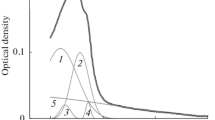Summary
The degradation of biological activity of virus-induced murine interferon was determined in linear nonisothermal and multiple isothermal tests. The stabilizing effect of pH during heating on interferon in solution was greatest at low pH, such that pH 2>pH 5>pH 7≥pH 9; freeze-dried preparations of interferon were also more heat-stable at acid pH than at neutral pH. Heat stability was a function of the H+-ion concentration rather than the ionic composition of the buffer; interferon solutions containing monovalent cations with different ionic radii had similar heat stability. A change in the H+ ion concentration was a critical event during the cooling of heated interferon: a shift in the direction of acidity contributed to stability whereas a shift towards alkalinity led to inactivation. The rate of cooling of heated interferon significantly influenced its residual activity. Rapid cooling and sudden freezing decreased the residual activities of interferons at pH 2 and 9 more than “normal” cooling, an effect not observed at pH 7. Interferon heated to 80° C could not be reactivated at 40° C or 55° C. Interferon of higher apparent molecular weight was more heat-stable than that with lower apparent molecular weight. It is postulated that the physicochemical alterations in the aqueous environment significantly affecting the stability of interferon operate by producing changes in the size and/or conformation of interferon molecules. A model is proposed that relates thermal inactivation to different possible molecular states of interferon.
Similar content being viewed by others
References
Bresler, S. E.: Introduction to molecular biology, 69–78. New York-London: Academic Press, 1971.
Chany, C., Ankel, H., Galliot, B., Chevalier, M. J., Gregoire, A.: Mode of action and biological properties of insoluble interferon. Proc. Soc. exp. Biol. Med.147, 293–299 (1974).
Cole, B. R., Leadbeater, L.: A critical assessment of an accelerated storage test. J. Pharm. Pharmac.18, 101–111 (1966).
Greiff, D., Greiff, C.: Linear nonisothermal single-step, stability studies of dried preparations of influenza virus. Cryobiology9, 34–37 (1972).
Greiff, D., Rightsel, W.: An accelerated storage test for predicting the stability of suspension of measles virus dried by sublimation in vacuo. J. Immunol.94, 395–400 (1965).
Grossberg, S. E.: The interferons and their inducers: molecular and therapeutic considerations. New Eng. J. Med.287, 13–19, 79–85, 122–128 (1972).
Grossberg, S. E., Greiff, D., Jameson, P.: Preservation of interferons: freezedrying and thermal inactivation. Symp. Series Immunobiol. Standard.14, 73–78. Basel-New York: Karger 1969.
Grossberg, S. E., Jameson, P., Sedmak, J. J.: Interferon bioassay methods and the development of standard procedures: a critique and analysis of current observations, in the production and use of interferon for the treatment and prevention of human virus infections.In vitro. Monograph No. 3, pp. 26–34 (1974).
Ho, M.: Interferon-like viral inhibitor in rabbits after intravenous administration of endotoxin. Science146, 1472–1474 (1964).
Isaacs, A.: Interferon. Adv. virus Res.10, 1–38 (1963).
Lampson, G. P., Tytell, A. A., Nemes, M. M., Hilleman, M. R.: Purification and characterization of chick embryo interferon. Proc. Soc. exp. Biol. Med.112, 468 to 478 (1963).
Lindenmann, J., Burke, D., Isaacs, A.: Studies on the production, mode of action and properties of interferon. Brit. J. exp. Pathol.38, 551–562 (1957).
Marshall, L. W., Pitha, P. M., Carter, W.: Inactivation of interferon: The effect of protonation. Virology48, 607–611 (1972).
Merigan, T. C., Winget, C. A., Dixon, C. B.: Purification and characterization of vertebrate interferons. J. mol. Biol.13, 679–691 (1965).
Oie, H. K., Buckler, C. E., Uhlendorf, C. P., Hill, D. A., Baron, S.: Improved assays for a variety of interferons. Proc. Soc. exp. Biol. Med.140, 1178–1181 (1972).
Tanford, C.: Protein denaturation. Parts A and B. Adv. Prot. Chem.23, 122–275 (1968).
Wheelock, E. F.: Interferon-like virus-inhibitor induced in human leukocytes by phytohemagglutinin. Science.149, 310–311 (1965).
Zoglio, M. A., Windheuser, J. J., Vatti, R., Maulding, H. V., Kornblum, S. S., Jacobs, A., Hamot, H.: Linear nonisothermal stability studies. J. pharm. Sci.57, 2080–2085 (1968).
Author information
Authors and Affiliations
Additional information
With 8 Figures
Rights and permissions
About this article
Cite this article
Jariwalla, R., Grossberg, S.E. & Sedmak, J.J. The influence of physicochemical factors on the thermal inactivation of murine interferon. Archives of Virology 49, 261–272 (1975). https://doi.org/10.1007/BF01317544
Received:
Accepted:
Issue Date:
DOI: https://doi.org/10.1007/BF01317544




